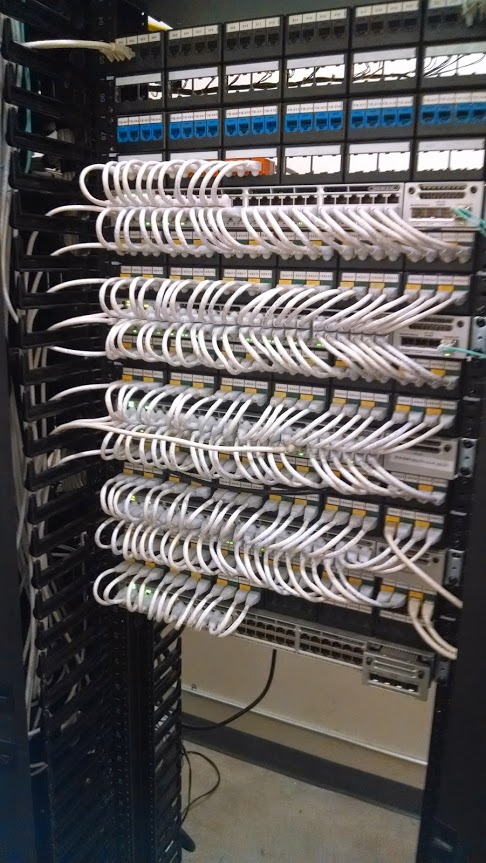With the move to a new organization comes some adjustment and occasionally some surprises. While my last employer was very rigid and bureaucratic, my new employer is extremely flexible, deplores ‘process for the sake of process’ and is extremely fast paced. There are pros and cons to everything in life although I’m not going to talk about my employers today.
Instead let’s talk about patching in the closet, sometimes referred to as the ICR (Intermediate Communications Room) but more often referred to as the IDF (Intermediate Distribution Frame). There are a few different mindsets when it comes to patching the data jack to the network switch. Some organizations, including my new employer, believe in 100% patching to eliminate the need for any local technician to patch ports. Some organizations believe in running lots of cabling, and only patching what’s needed at that point in time. In July 2012 I showed off some of the closets that I personally built and others that I inherited in a post titled, Wiring Closets – Done Right!
 Here’s a recently constructed IDF with a stack of Cisco 3850X switches and 6″ patch cables. It looks pretty clean doesn’t it? Although, you can see that the 6″ patch cable doesn’t allow too many options when patching the data jack. You essentially need to connect the data jack to the switch port either directly above or below the patch panel.
Here’s a recently constructed IDF with a stack of Cisco 3850X switches and 6″ patch cables. It looks pretty clean doesn’t it? Although, you can see that the 6″ patch cable doesn’t allow too many options when patching the data jack. You essentially need to connect the data jack to the switch port either directly above or below the patch panel.
I would probably personally choose a 1′ patch cable to allow a little more freedom and slack. There are no free rack units in that layout so replacing a failed switch will require the engineer to label some if not all of the ports, remove the cables, remove the failed switch and reverse the process. In previous switch stack deployments I had left 1 open RU below every switch so a technician could place a new switch in the rack (put the switch in from the rear if necessary then install the ears) and then just move the patch cables to the new switch.
There are pros and cons to each approach, it really depends on the organization and what makes sense for them and how they do business.
How to you patch your closets?
Are you still using chassis based switches?
Cheers!
I don’t have any good pictures handy to post at the moment, but here’s our general starting point for a design:
* Left hand rack is for cable termination points. We use 4U 48 port panels, alternated with 2U horizontal cable management.
* Right hand rack is for fiber termination and equipment. LIU for fiber goes at the top, then the switches roughly in the middle, and finally UPS in the bottom.
* Patch cords are loosely packed from the patch panel into the vertical cable guide between the two racks, then velcroed into 48 port bundles that go to the switches. All patch cords are 7′ lengths, which doesn’t typically overflow with too much slack, but leaves enough of a service loop to slide a single switch out, install the replacement, and individually migrate the patch cords out without the intermediate labeling mess.
Now to be fair, we came up with this plan on much earlier switches (Nortel 8100 chassis, a mercifully short lived product) that had a far higher failure rate than the ones we rely on now (Juniper EX4200). That said, it still gives us a lot of flexibility for any cases where we have to relocate equipment or shuffle patch cords around. The bundling is less convenient to trace out cables, but we deal with this by keeping ruthlessly complete and accurate records of what goes where (we have a project around retooling this documentation if anyone is interested).
For a long time we had a general rule about stacks – no more than two members, or else we switch over to a chassis model. This came about because there was so much ambiguity and so many operational edge cases – reset that one then that one, and try to guess who’s master sort of problems. Nowadays the Juniper EX stacking is far, far more straightforward, so we’ve gone completely over to stacking everywhere outside of the core.
Thanks for the comment Frank.
The only rule I try to follow when using switch stacks is to avoid using them as core switches whenever possible. It’s much more stable to separate your core switch from say a stack of server or edge switches even if they physically sit you in your MDF/CCR.
Cheers!